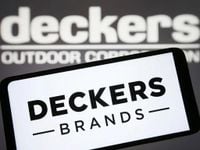Deckers Outdoor Corporation, the company behind household footwear names like Hoka and UGG, delivered a stark wake-up call to the retail world on October 24, 2025. Despite reporting robust quarterly earnings, the company’s shares tumbled nearly 14% in a single day, extending a precipitous decline that has wiped out nearly half its market value this year. The culprit: a cocktail of persistent tariffs, rising costs, and increasingly cautious American shoppers, all of which have forced Deckers to slash its full-year sales forecast and warn of tougher times ahead.
According to Market Minute, Deckers’ revised guidance projects annual sales of $5.35 billion—falling short of Wall Street’s $5.45 billion expectations. This move rattled investors, especially since the company’s fiscal second-quarter results had otherwise impressed, with earnings per share reaching $1.82 and revenue climbing 9.1% year-over-year to $1.43 billion. But as CEO Stefano Caroti explained during the earnings call, strong past performance is no guarantee of future success in today’s volatile landscape. “We expect a more cautious consumer as the full impact of tariffs and price increases will be felt here in the U.S.,” Caroti warned, highlighting a shift in consumer sentiment that could reshape the entire sector.
The hit to Deckers’ bottom line is coming from several directions, but none more so than U.S. tariffs on imported footwear. The company sources much of its product from Vietnam, where tariffs can reach as high as 40%. CFO Steven Fasching was blunt about the impact: Deckers expects up to $150 million in additional costs for fiscal 2026 directly from these tariffs, putting significant pressure on gross margins. Even a round of price hikes in July wasn’t enough to offset the damage, leading to a 1.7% dip in U.S. sales this quarter—a sharp reversal from the 14.2% surge seen a year ago.
Deckers is hardly alone. The entire footwear industry is feeling the squeeze as trade tensions and inflation ripple through global supply chains. Tariffs on footwear imports from Vietnam have jumped 46%, with similar spikes from Indonesia (32%) and China (54%), according to Market Minute. These increases disrupt logistics, drive up production costs, and force brands to rethink their sourcing strategies. The unpredictable nature of trade policy only adds to the uncertainty, making long-term planning a headache for even the most seasoned executives.
For the broader economy, the stakes are high. The National Retail Federation estimates that U.S. consumers could lose between $46 billion and $78 billion in annual spending power due to tariffs, with $6.4 billion to $10.7 billion hitting footwear purchases directly. Retail data from January 2025 paints a grim picture: shoe store sales dropped nearly 8% year-over-year, a clear sign that consumers are cutting back. Surveys suggest the average shopper will trim their footwear budget by about $35 in the coming year, and price sensitivity is on the rise as inflation bites into household budgets.
Deckers’ warning sent ripples through the retail sector, raising concerns that the consumer discretionary spending environment could be far more challenging than previously thought. Brands that rely heavily on imports and shoppers’ extra cash—especially those with less flexible production or weaker pricing power—could see more volatility ahead. As The Market Minute points out, even giants like Nike and Adidas aren’t immune. Nike has already reported a drop in global market share and unsold inventory headaches, while Adidas has seen flat performance in key markets. If consumers continue to tighten their belts, these brands may be forced to ramp up promotions, further squeezing margins.
On the flip side, companies offering value and comfort at accessible price points could emerge as relative winners. Crocs, with its affordable and comfortable footwear, and Skechers, known for its value-oriented athletic shoes, are well-positioned to attract cost-conscious consumers trading down from premium brands. Crocs’ acquisition of HeyDude strengthens its hold on the casual sneaker segment, while Skechers has a track record of thriving during economic uncertainty by luring shoppers away from pricier competitors.
Deckers itself is not sitting still. The company is doubling down on supply chain diversification, international expansion—especially in Asia and Europe—and investing in direct-to-consumer (DTC) channels to boost margins and customer engagement. These moves are designed to cushion the blow from tariffs and give Deckers more control over its destiny. But as the company’s recent performance shows, even the best-laid plans can be buffeted by forces beyond management’s control.
The footwear industry’s current predicament is, in many ways, a microcosm of broader economic trends. U.S. tariffs on consumer goods are among the highest in the world, averaging 12.3% for footwear alone. Industry groups like the Footwear Distributors and Retailers of America (FDRA) have been vocal in their opposition, warning that such measures could lead to store closures, job losses, and increased financial strain for American families. History offers a sobering perspective: past tariff regimes, like the 1890 McKinley Tariff and the 1930s Smoot-Hawley Tariff, triggered price surges, retaliatory trade measures, and even contributed to economic recessions.
Looking ahead, the coming months will be a test of resilience for Deckers and its peers. The company plans to manage margin pressure through selective price increases and operational efficiencies, but with tariffs expected to persist through 2027, the challenges are unlikely to fade soon. Brands will need to innovate—leveraging technology like AI for demand forecasting and AR for virtual try-ons—to stay ahead of shifting consumer preferences. Comfort, functionality, and sustainability will be key differentiators as shoppers become more discerning.
Industry analysts expect heightened promotional activity and fiercer price competition as companies vie for a shrinking share of consumers’ wallets. Those with strong brand equity and diversified operations, like Deckers, may weather the storm—albeit with slower growth. But premium-only or less nimble players could face more severe headwinds, potentially leading to market shakeouts or strategic overhauls.
Deckers Outdoor’s October 24 share plunge is more than just a blip on the stock ticker—it’s a flashing warning light for the entire retail landscape. As tariffs and inflation reshape consumer behavior and corporate strategies, the companies that can adapt quickly and offer compelling value will be best positioned to thrive. For now, though, the road ahead looks anything but smooth for America’s favorite footwear brands.





